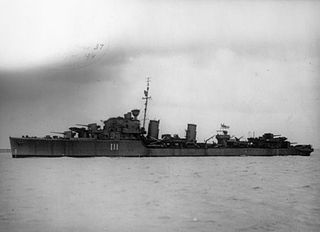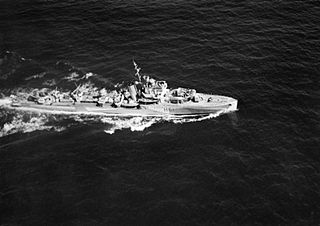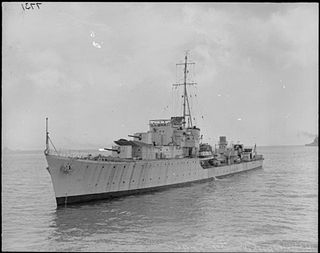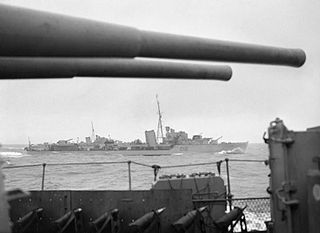
HMS Ivanhoe was an I-class destroyer built for the Royal Navy in the mid-1930s. During the Spanish Civil War of 1936–1939, the ship enforced the arms blockade imposed by Britain and France on both sides as part of the Mediterranean Fleet. Before the start of World War II, the ship was modified so that she could be used to lay mines by removing some of her armament. Ivanhoe was transferred to Western Approaches Command shortly after the war began and helped to sink one German submarine in October 1939. She was converted to a minelayer while undergoing a refit in November–December and laid minefields in German coastal waters as well as anti-submarine minefields off the British coast until she was reconverted back to her destroyer configuration in February 1940. Ivanhoe reverted to her minelaying role during the Norwegian Campaign in April 1940 and then laid a number of minefields off the Dutch coast during the Battle of the Netherlands in May. The ship participated in the Dunkirk evacuation until she was badly damaged by German aircraft on 1 June. On her first minelaying mission after her repairs were completed, she struck a German mine and had to be scuttled on 1 September 1940 during the Texel Disaster.

HMS Impulsive was an I-class destroyer built for the Royal Navy during the 1930s. She saw service in World War II before being scrapped in 1946. She has been the only ship of the Navy to bear this name.

HMS Cossack was a Tribal-class destroyer named after the Cossack people of the Eurasian steppe. She became famous for the boarding of the German supply ship Altmark in Norwegian waters, and the associated rescue of sailors originally captured by the Admiral Graf Spee. She was torpedoed by the German submarine U-563 on 23 October 1941, and sank four days later.

HMS Kandahar (F28) was a K-class destroyer built for the Royal Navy during the 1930s, named after the Afghan city of Kandahar.

HMS Express was an E-class minelaying destroyer built for the Royal Navy in the early 1930s. Although assigned to the Home Fleet upon completion, the ship was attached to the Mediterranean Fleet in 1935–36 during the Abyssinia Crisis. During the Spanish Civil War of 1936–1939, she spent considerable time in Spanish waters, enforcing the arms blockade imposed by Britain and France on both sides of the conflict.

HMS Icarus was one of nine I-class destroyers built for the Royal Navy during the 1930s.

The O and P class was a class of destroyers of the British Royal Navy. Ordered in 1939, they were the first ships in the War Emergency Programme, also known as the 1st and 2nd Emergency Flotilla, respectively. They served as convoy escorts in World War II, and some were subsequently converted to fast second-rate anti-submarine frigates in the 1950s.

HMS Amazon was a prototype design of destroyer ordered for the Royal Navy in 1924. She was designed and built by Thornycroft in response to an Admiralty request for a new design of destroyer incorporating the lessons and technological advances of the First World War. Their great rivals Yarrow produced a similar, competitive design — that of Ambuscade.

The J, K and N class consisted of 24 destroyers built for the Royal Navy beginning in 1938. They were a return to a smaller vessel, with a heavier torpedo armament, after the Tribal class that emphasised guns over torpedoes. The ships were built in three flotillas or groups, each consisting of eight ships with names beginning with "J", "K" and "N". The flag superior of the pennant numbers changed from "F" to "G" in 1940.

HMS Matabele was a Tribal-class destroyer of the Royal Navy that saw service in World War II, being sunk by a U-boat on 17 January 1942. She has been the only ship of the Royal Navy to bear the name Matabele, which in common with the other ships of the Tribal class, was named after an ethnic group of the British Empire. In this case, this was the Anglicisation of the Ndebele people of Zimbabwe.

HMS Somali was a Tribal-class destroyer of the British Royal Navy that saw service in World War II. She was launched in 1937, captured the first prize of World War II and served in Home and Mediterranean waters. She was torpedoed on 20 September 1942 in the Arctic and foundered five days later while under tow.

HMS Bedouin was a Tribal-class destroyer of the British Royal Navy that saw service in World War II.

HMS Basilisk was a B-class destroyer built for the Royal Navy around 1930. Initially assigned to the Mediterranean Fleet, she was transferred to the Home Fleet in 1936. The ship escorted convoys and conducted anti-submarine patrols early in World War II before participating in the Norwegian Campaign. Basilisk was sunk by German aircraft during the Dunkirk evacuation in 1940.

HMS Brazen was a B-class destroyer built for the Royal Navy around 1930. Initially assigned to the Mediterranean Fleet, she was transferred to Home Fleet in 1936. The ship escorted convoys and conducted anti-submarine patrols early in World War II before participating in the Norwegian Campaign in April–May 1940. Brazen later began escorting coastal convoys in the English Channel and was sunk in late July 1940 by German aircraft whilst doing so.

HMS Kashmir (F12) was a K-class destroyer built for the Royal Navy during the 1930s, named after the princely state of Kashmir in British India.

HMS Active, the tenth Active, launched in 1929, was an A-class destroyer. She served in the Second World War, taking part in the sinking of four submarines. She was broken up in 1947.

HMS Escapade was an E-class destroyer built for the Royal Navy in the early 1930s. Although assigned to the Home Fleet upon completion in 1934, the ship was attached to the Mediterranean Fleet in 1935–1936 during the Abyssinia Crisis. During the Spanish Civil War of 1936–1939 she spent considerable time in Spanish waters, enforcing the arms blockade imposed by Britain and France on both sides of the conflict. Escapade was assigned to convoy escort and anti-submarine patrol duties in the Western Approaches when World War II began in September 1939, but transferred back to the Home Fleet at the end of the year.

HMS Esk was an E-class destroyer built for the Royal Navy in the early 1930s. She was designed to be easily converted into a fast minelayer by removing some guns and her torpedo tubes. Although assigned to the Home Fleet upon completion, the ship was attached to the Mediterranean Fleet in 1935–36, during the Abyssinia Crisis. During the Spanish Civil War of 1936–1939, she spent considerable time in Spanish waters, enforcing the arms blockade imposed by Britain and France on both sides of the conflict. Esk was converted to a minelayer when World War II began in September 1939, and spent most of her time laying mines. During the Norwegian Campaign of April–June 1940, the ship laid mines in Norwegian territorial waters before the Germans invaded, but was recalled to home waters to resume her minelaying duties in early May. During one such sortie, Esk was sunk during the Texel Disaster on the night of 31 August 1940, when she ran into a newly laid German minefield.

HMS Havelock was an H-class destroyer that had originally been ordered by the Brazilian Navy with the name Jutahy in the late 1930s, but was bought by the Royal Navy after the beginning of the Second World War in September 1939 and later renamed. She participated in the Norwegian Campaign in May 1940 and was assigned to convoy escort and anti-submarine patrols with the Western Approaches Command afterwards. The ship was briefly assigned to Force H in 1941, but her anti-aircraft armament was deemed too weak and she rejoined Western Approaches Command. Havelock became flotilla leader of Escort Group B-5 of the Mid-Ocean Escort Force in early 1942 and continued to escort convoys in the North Atlantic for the next two years. The ship was converted to an escort destroyer and sank one submarine during the war. After the end of the war, she escorted the ships carrying the Norwegian government in exile back to Norway and served as a target ship through mid-1946. Havelock was scrapped beginning in late 1946.

HMS Kipling (F91) was a K-class destroyer built for the Royal Navy during the 1930s.





















